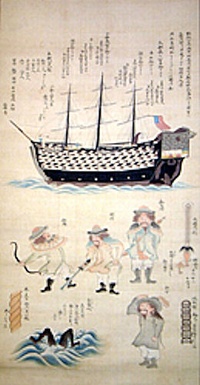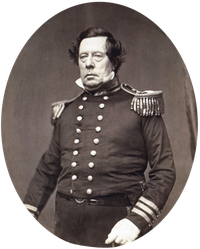HAJIMEMASHITE!
It all began in 1846, when US Navy Commander James Biddle invaded Edo Bay with two American ships; he tried to negotiate a treaty with Japan, and, after an ungracious incident involving the Bakufu—the military regime—he was evicted with a firm No! Biddle returned to America with his coattails between his legs, and the warning that all international matters HAD to go through Nagasaki.2
In 1849, US Navy Captain James Glynn followed Biddle’s attempt, and made it to Nagasaki. He had come in the American brig USS Preble, to rescue a party of shipwrecked American whalers held by the Japanese. Glynn had to force his entry into the bay, and threatened major havoc if the prisoners were not released to him. He got his way, and returned to America.3 Among those rescued was a most delightful character: the first teacher of English in Japan, the Native-American Ranald MacDonald.4
Bluffing with a single ship was not the ideal way to deal with Japan, Glynn concluded; rather, negotiations should be supported with a full force demonstration. Glynn approached the US Congress, with his idea of gunboat diplomacy, and the august body Aha-aha-ed it.
US Navy Commodore Matthew C. Perry visited next, on July 8, 1853, with four well-armed ships. Though directed to anchor at Nagasaki, he literally stuck by his guns and trained them on Uraga, in Edo Bay. He managed to force the Bakufu to accept an ultimatum by US President Millard Fillmore to the Japanese Emperor, for contact between the two countries.
Perry warned his uneasy hosts that he would return in a year.
—With all four vessels?
—Probably more.5
The Commodore was back with seven ships in February 1854; he was informed that most of President Fillmore’s demands had been heeded, and on March 31, he signed the Convention of Kanagawa6 —an agreement between the Tokugawa—the ruling oligarchy—and the United States. Four years later, the two nations replaced it with the United States-Japan Treaty of Amity and Commerce.7 Having been strangle-held into amity, Japan could do nothing better to show it than to exempt American residents from local jurisdiction, and grant them a few other galling perks. And so, Sakoku—the closed door period—was sent to rest uncomfortably into the Japanese past immemorial.
Had Japan really been the hermetic, exotic, inscrutable or singular Far East of popular lore?8 Let’s ruminate on history a little.
Since the 16th century, distinguished visitors such as Francis Xavier, Alessandro Valignano, Joao Rodriguez, Richard Cocks, Will Adams, François Caron, and others, all had raved about what they had discovered.9 The many Portuguese, Spanish, English and Dutch traders who had come to Japan’s shores had ranted about its culture and accomplishments. They had also exported Japanese weapons, armor, screens, lacquers, textiles, paintings, faience, porcelain, carvings, and golden treasures, all to enrich the libraries, churches, and manors of the European gentry.
For some two-hundred-and-thirty years after imposing Sakoku, Japan had remained open to business with the Dutch, the English10, the Chinese, the Ryukuan, and the Korean.11 Between 1797 and 1809, several American ships had also traded in Nagasaki under the Dutch flag.12 Throughout all that time, in Europe, those who cared had improved their knowledge about Japan, thanks to dedicated scientists such as German Physician Engelbert Kaempfer, (1651-1716); Swedish botanist Carl Peter Thunberg, (1743-1828); and German Dr. Philipp Franz von Siebold, (1796-1866).13 Moreover, since 1710, German manufactories had already begun copying Japanese porcelain, particularly the kakiemon,14 which they marketed under the name Meissen china.15 And to imitate the exquisiteness of Japanese lacquer arts, japanning had became quite popular, especially in Britain. No longer was Japanese art the exclusive turf of the privileged; the bourgeoisie too, would gladly pay good prices for both imports and imitations.
One can be sure that, as time went on, Dutch merchants found, enjoyed, and shared Japanese paintings and ukiyo-e prints among themselves—if nothing else to relieve the dismal monotony of their isolation in tiny Deshima. Many of those prints—shunga (erotic works) included—found their way to Europe legally, or smuggled by entrepreneurs such as Dutch VOC Opperhoofd, Isaac Titsingh.16
So, why all the fuss about the leaky Sakoku?
Perhaps American power barons resented both the Dutch trading monopoly with Japan, and the British hegemony in China. Perhaps, with half of Mexico in America’s pocket and Hawaii about to fall in, they intended to improve their country’s image within the colonialist clique.17 Or maybe… they were readying a modern Christian Crusade.18
Notes:
1. East is East and West is West and never the twain shall meet. Rudyard Kipling. The Ballad of East and West. 1889
2. F. Brinkley, A History of the Japanese People, (New York: The Encyclopaedia Britannica Co., 1915). Also: David F. Long, Sailor-Diplomat: A Biography of Commodore James Biddle, 1783-1848, (Boston: Northeastern University Press, 1983).
3. Brinkley, 663.
4. JAPAN—An Illustrated Encyclopedia, (Tokyo: Kodansha, 1993. Vol. II). See also, Frederik L. Schodt, Native American in the Land of the Sun, (Berkeley: Stone Bridge Press, 2003), 316-22.
5. C. Veit, Matthew Perry and the Opening of Japan, http://www.navyandmarine.org/ondeck/1800perryjapan.htm.
6. Ibid.
7. For the full text, see David J. Lu, Japan A Documentary History, (New York: M.E. Sharpe, 1997; 288-92.
8. Toshio Yokoyama, Japan in the Victorian Mind, (London: The MacMillan Press, 1989), Chapter 1.
9. Michael Cooper, They Came to Japan, (Berkeley: University of California Press. 1965).
10. Until the closing of Hirado.
11. See http://www.centraljapan.jp/history_details.php?id=73
12. The Dutch were then involved in a war with Britain, and there were still some bones of contention between England and America.
13. See: http://www.baxleystamps.com/litho/kaempfer_1906.shtml. See also
Lionel Lambourne, Japonisme –Cultural Crossings between Japan and the West, (London: Phaidon Press, 2005), 7-24.
14. Sakaida Kakiemon (1596-1666) was the originator of the ‘multicolor pictured ware’, which allowed the subdued Imari porcelain to be brilliantly over-glazed with a variety of exciting colors. See Noma Seiroku, The Arts of Japan – Late Medieval to Modern, (Tokyo: Kodansha, 1980), 162-63.
15. By 1730, France also began copying Japanese porcelain. The results were Saint-Cloud, Chantilly, Vincennes, and Sèvres porcelains. For further details, see http://en.wikipedia.org/wiki/French_porcelain
16. After Sakoku was imposed, the Opperhoodf (supreme head) was the Chief Trader or Factor of the Vereenigde Oostindische Compagnie, VOC or Holland’s United East Indian Company.
17. James A. B. Scherer, The Romance of Japan through the Ages, (Tokyo: The Hokusaido Press, 1934), 217-22.
18. These hypotheses offer a most delightful area for further research on what really triggered “the Opening of Japan.” See Yokoyama, 18; and Veit; Op.cit.
© 2012 Edward Moreno








